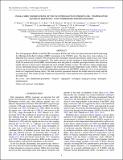Files in this item
CHARA/MIRC observations of two M supergiants in perseus OB1 : temperature, Bayesian modeling, and compressed sensing imaging
Item metadata
| dc.contributor.author | Baron, F. | |
| dc.contributor.author | Monnier, J.D. | |
| dc.contributor.author | Kiss, L.L. | |
| dc.contributor.author | Neilson, H.R. | |
| dc.contributor.author | Zhao, M. | |
| dc.contributor.author | Anderson, M. | |
| dc.contributor.author | Aarnio, A. | |
| dc.contributor.author | Pedretti, E. | |
| dc.contributor.author | Thureau, N. | |
| dc.contributor.author | Ten Brummelaar, T.A. | |
| dc.contributor.author | Ridgway, S.T. | |
| dc.contributor.author | McAlister, H.A. | |
| dc.contributor.author | Sturmann, J. | |
| dc.contributor.author | Sturmann, L. | |
| dc.contributor.author | Turner, N. | |
| dc.date.accessioned | 2014-09-01T14:31:01Z | |
| dc.date.available | 2014-09-01T14:31:01Z | |
| dc.date.issued | 2014-04-10 | |
| dc.identifier | 145056239 | |
| dc.identifier | fe88bb77-5eb9-478d-aac5-efb96728d3cb | |
| dc.identifier | 84897466016 | |
| dc.identifier | 000335639300046 | |
| dc.identifier.citation | Baron , F , Monnier , J D , Kiss , L L , Neilson , H R , Zhao , M , Anderson , M , Aarnio , A , Pedretti , E , Thureau , N , Ten Brummelaar , T A , Ridgway , S T , McAlister , H A , Sturmann , J , Sturmann , L & Turner , N 2014 , ' CHARA/MIRC observations of two M supergiants in perseus OB1 : temperature, Bayesian modeling, and compressed sensing imaging ' , Astrophysical Journal , vol. 785 , no. 1 . https://doi.org/10.1088/0004-637X/785/1/46 | en |
| dc.identifier.issn | 0004-637X | |
| dc.identifier.uri | https://hdl.handle.net/10023/5302 | |
| dc.description | The authors acknowledge funding from the NSF through award AST-0807577 to the University of Michigan, as well as funding by the Australian Research Council and the "Lendület Fiatal Kutatói Program" of the Hungarian Academy of Sciences for the initial work on these objects. | en |
| dc.description.abstract | Two red supergiants (RSGs) of the Per OB1 association, RS Per and T Per, have been observed in the H band using the Michigan Infra-Red Combiner (MIRC) instrument at the CHARA array. The data show clear evidence of a departure from circular symmetry. We present here new techniques specially developed to analyze such cases, based on state-of-the-art statistical frameworks. The stellar surfaces are first modeled as limb-darkened disks based on SATLAS models that fit both MIRC interferometric data and publicly available spectrophotometric data. Bayesian model selection is then used to determine the most probable number of spots. The effective surface temperatures are also determined and give further support to the recently derived hotter temperature scales of RSGs. The stellar surfaces are reconstructed by our model-independent imaging code SQUEEZE, making use of its novel regularizer based on Compressed Sensing theory. We find excellent agreement between the model-selection results and the reconstructions. Our results provide evidence for the presence of near-infrared spots representing about 3%-5% of the stellar flux. | |
| dc.format.extent | 13 | |
| dc.format.extent | 2144824 | |
| dc.language.iso | eng | |
| dc.relation.ispartof | Astrophysical Journal | en |
| dc.subject | Stars: fundamental parameters | en |
| dc.subject | Starspots | en |
| dc.subject | Supergiants | en |
| dc.subject | Techniques: image processing | en |
| dc.subject | Techniques: interferometric | en |
| dc.subject | QB Astronomy | en |
| dc.subject | QC Physics | en |
| dc.subject.lcc | QB | en |
| dc.subject.lcc | QC | en |
| dc.title | CHARA/MIRC observations of two M supergiants in perseus OB1 : temperature, Bayesian modeling, and compressed sensing imaging | en |
| dc.type | Journal article | en |
| dc.contributor.sponsor | Science & Technology Facilities Council | en |
| dc.contributor.institution | University of St Andrews. School of Physics and Astronomy | en |
| dc.identifier.doi | 10.1088/0004-637X/785/1/46 | |
| dc.description.status | Peer reviewed | en |
| dc.identifier.grantnumber | ST/J001651/1 | en |
This item appears in the following Collection(s)
Items in the St Andrews Research Repository are protected by copyright, with all rights reserved, unless otherwise indicated.

